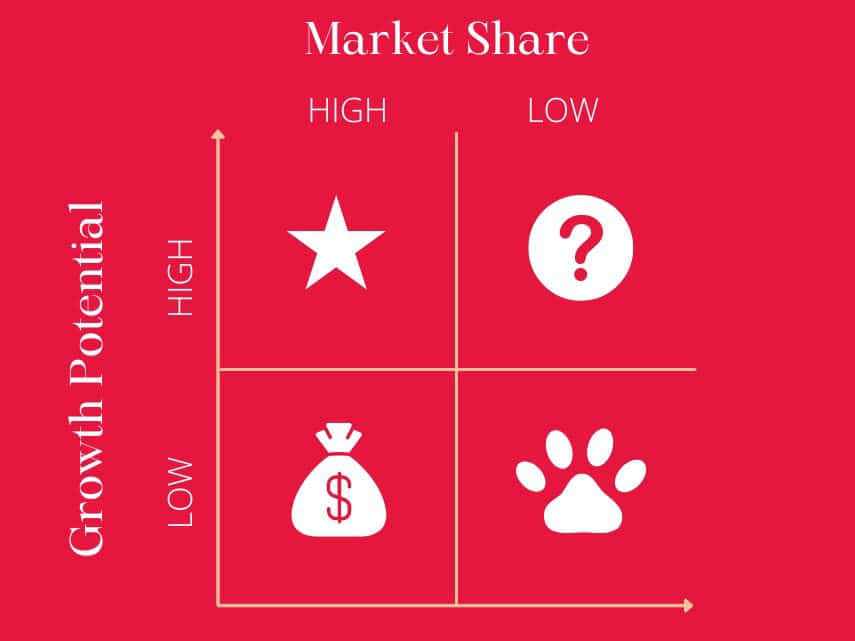
If you’ve got a business that’s doing well, you’ll want to expand on that success, right?
But not all growth is sustainable. To scale your business affordably, you need a diversified product portfolio that perfectly balances cash flow with product development and marketing.
What is a product portfolio?
A product portfolio is the complete collection of products and services sold by a company.
It serves as the first data point when reviewing the value of a product or service as it pertains to business growth and cash flow. This assessment is called product portfolio analysis.
Similar to an investment portfolio, it’s considered best practice to diversify your product portfolio. This is achieved by selling a range of products with varying degrees of relative market share and growth potential. Diversification ensures your business is primed for sustainable scaling and maximum success.
 A diversified product portfolio helps businesses to stay financially afloat during growth periods.
A diversified product portfolio helps businesses to stay financially afloat during growth periods.
Product management vs. product portfolio management
Product portfolio management is sometimes confused with product management, but they’re not the same.
Here’s the difference:
- Product management is performed by Product Managers and involves the development of a strategy and roadmap for a single product.
- Product portfolio management is performed by a Product Portfolio Manager and involves overseeing all aspects of a business’s entire product catalogue.
A product portfolio manager will frequently liaise with product managers to keep the product portfolio up to date and identify reasons behind a specific product’s performance.
How company size affects product portfolio strategy
Mature companies typically have more diverse product portfolios than newer ones. This is because they’ve had more time to develop and expand their catalogue.
Young companies usually have tighter product portfolios, putting them at greater risk. They must rely more heavily on the performance of their main products, leading to greater operational volatility. The impact of changes affecting these products on the business tends to be much greater.
As a result, the targets and strategies for product portfolio management differ between mature and young businesses.
Mature businesses will have a stronger focus on diversifying their portfolio and reinvesting the capital from their top-performing products into new innovations.
Conversely, young businesses should direct their focus towards developing winning products that will fund future growth.
Why a portfolio of products is important for growth
“If done correctly, diversification provides a tremendous boost to brand image and company profitability.”
The driving purpose of a product portfolio is to help businesses identify their best- and worst-performing products as they relate to sustainable business growth. This doesn’t necessarily mean your best and worst sellers – or even your products with the broadest margins.
Product portfolios are all about creating a diverse range of products with different degrees of growth potential and market share.
Product portfolio and cash flow
A balanced product portfolio is one that has been optimised to produce healthy cash flow.
Growth requires cash. A reinvestment of profits from your products is necessary to keep growing. Therefore, the more cash a product brings in the faster you can scale your business.
Insufficient cash flow can lead to:
- Stagnated growth
- Missed bill payments
- Unhappy staff
- Unhappy customers
- Insolvency
- Liquidation
There is a finite point where all product markets eventually stop growing: When the rate of return exceeds the growth rate, it’s no longer a good idea to keep reinvesting in that product. Instead, profits from slow-growth products with high market share can be used to develop new products and diversify your portfolio.
Diversifying your product portfolio aims to ensure there is sufficient cash flow from mature products available to raise the market share of newer products. This system creates a cycle for consistent growth.
- Learn more: Common Cash Flow Problems & How to Solve Them
 A product portfolio can provide insights into where your profits and growth potential are highest.
A product portfolio can provide insights into where your profits and growth potential are highest.
5 benefits of an optimised product portfolio
“Product diversification can help companies build robust brands with strong visibility.”
An optimised product portfolio has the right balance of cash flows – through ample diversification – to support efficient growth.
Here are five key benefits of optimising your product portfolio:
- Spread the risk. When you diversify your product line, you’re able to collect revenue from different markets.
- Evaluate product performance. Product portfolios allow you to take a data-driven, systematic approach to product performance analysis and product catalogue optimisation.
- Identify innovation opportunities. Portfolio diversification can often lead to exciting new ideas, rebranding, and a more market-friendly catalogue.
- Prevent cash flow freezes. Consistent cash flow is crucial for day-to-day activities. An optimised portfolio is one that contributes to healthy cash flow.
- Economically allocate resources. Reviewing the performance and growth rate of your products aids in decision-making. You’ll make better-informed choices around which products should be obsoleted and which should be assigned extra resources.
A product portfolio should not be considered a nice-to-have, but an essential tool for driving the growth of your business.
What is product portfolio analysis?
Product portfolio analysis is the task of assessing all the products your business sells for performance, growth potential, and market share.
Portfolio analyses are conducted to help businesses understand how their various products are contributing to cash flow. The data produced by a product portfolio analysis can be used to inform where resources should be allocated and when.
Product portfolio analysis strategies
Ultimately, a product portfolio analysis seeks to categorise products based on their individual market share and growth rate. Here are some ways you can do that.
The BCG Growth Share Matrix
The BCG Growth Share Matrix is a framework for product portfolio management and analysis. It was published by the Boston Consulting Group in 1970, and at one point was used by about 50% of all Fortune 500 companies.
The BCG matrix looks like a graph split into four quadrants. These quadrants each represent a certain degree of profitability:
 The BCG Growth-Share Matrix analyses the products in your portfolio for profitability based on growth rate and market share.
The BCG Growth-Share Matrix analyses the products in your portfolio for profitability based on growth rate and market share.
In a product portfolio analysis, products are categorised by their position on the matrix. Product value is determined by the product’s ability to obtain a leading share of its market before growth slows.
The four categories of product in the BCG Growth Share matrix:
- Stars: These are products with high relative market share and high industry growth rate. Stars should receive significant investment, as they have the highest future potential.
- Cash cows: These are products with high relative market share and low industry growth rate. Cash cows should be milked for cash to reinvest in other products.
- Question marks: These are products with low relative market share and high industry growth rate. Question marks with the potential to become stars should be invested in more deeply. Question marks without the potential to become stars should be removed from your portfolio.
- Pets: These are products with high relative market share and low industry growth rate. Pets are not beneficial to business growth and should therefore be liquidated, divested, or repositioned.
All products will eventually become cash cows (winners) or pets (failures). Any profits made from cash cows should be invested into turning question marks into stars.
The GE–McKinsey Nine-Box Matrix
The GE–McKinsey Nine-Box Matrix was developed in the 1970s, shortly after (and inspired by) the BCG Growth Share Matrix.
It was created when General Electric (GE) engaged McKinsey & Company for advice on managing its complex product portfolio. The result was a nine-box matrix that was quickly adopted by many large businesses around the world.
There are two main differences between the matrices:
- The nine-box matrix has – you guessed it – nine boxes, introducing a “Medium” row and column to the table.
- The X-axis and the Y-axis of the nine-box matrix represent Competitive Strength and Industry Attractiveness.
Unlike the BCG matrix, this one is termed a multifactor portfolio matrix.
In short, the GE–McKinsey matrix is the more complex of the two which can make it more difficult to understand. But, since it’s more detailed, it can also provide better insights.
Product life cycle analysis
The product life cycle is another way of analysing where a product sits in your product portfolio.
Unlike the last two strategies, the product life cycle is not a visual matrix or graph – it’s a concept.
There are four phases in the product life cycle:
- Introduction stage
- Growth stage
- Maturity stage
- Decline stage
In the introduction stage, customers are introduced to a new product. Investments are made in product awareness marketing and advertising campaigns to drive customer engagement.
If the product is successful (it sells!) then it is moved to the growth stage. Demand increases alongside production and availability. Investments shift from awareness-focused to USP-focused as marketing campaigns aim to differentiate the product from the competition.
When a product reaches the apex of its profitability, it enters the maturity stage. This is where production and marketing costs drop, and profit margins start to shrink.
Finally, the decline stage is where a product loses its market share and sales begin to drop due to saturation and alternatives.
Product life cycles are implemented to make better decisions around products, such as pricing changes or obsoletion.
 Product portfolio analysis helps you to identify which products deserve greater investment and which should be removed from your catalogue.
Product portfolio analysis helps you to identify which products deserve greater investment and which should be removed from your catalogue.
8 useful product portfolio management tips
“To counter spiralling complexity, companies can establish effective portfolio management—and with it, an ongoing practice of pruning their portfolios.”
Product portfolio management is the evaluation and prioritisation of your products. This includes optimising the allocation of resources based on your findings.
Here are our best tips for managing your product portfolio:
- Set a regular (monthly, quarterly, or yearly) schedule for conducting analyses of both your product portfolio and current market trends.
- Weigh in all factors that could affect future product performance, including seasonality, global crises, political disputes, and a shift in customer demand.
- Invest in a robust inventory management system with reporting features to ensure the product data in your portfolio is 100% accurate and updated in real-time.
- There is such a thing as too diverse; it’s best to start with a tight portfolio of high-quality, low-cost products and then expand affordably as you grow.
- Avoid emotional responses to market fluctuations and product failings – think with your business mind, not your heart.
- Consider possible risks, customer and stakeholder needs, and long-term market value projections.
- Remain innovative as you grow; always be looking for new investment opportunities and potential competitive advantages.
- When culling products from your portfolio, focus on low performance (not necessarily low sales).
Product portfolio management is a fine balancing act between product development, operations, sales, and finance. Try to get as many people from different departments on board with the process so that you’re aware of all risks and opportunities.
Product portfolio examples
Product portfolios come in many shapes and sizes, but the most common is a simple table format.
To gain a better idea of how they work, check out these product portfolio examples from famous brands (and us!).
Coca-Cola’s product portfolio
First up, here’s an example of Coca-Cola’s beverage product portfolio:
|
Coffee & Tea |
Juices, Dairy & Plant-based |
Sparkling Soft Drinks |
Waters & Hydration |
Ready-to-Drink Alcohol |
|---|---|---|---|---|
|
|
|
|
|
Were you aware all of these products are made by the Coca-Cola Company?
As you can see, they’ve diversified their portfolio to serve multiple markets across multiple regions.
Apple’s product portfolio
Next, check out this example of Apple’s product portfolio:
|
Computers |
Phones |
Tablets |
Watches |
Accessories |
TV & Home |
|---|---|---|---|---|---|
|
|
|
|
|
|
This is only a taste of the products Apple are currently selling – their real product portfolio would have you scrolling for days.
Unleashed’s product portfolio
We've also got a product portfolio, so why not use ourselves as an example?
Here’s Unleashed’s product portfolio:
|
Subscriptions |
Upgrades |
Services |
|---|---|---|
|
|
|
Manage your product portfolio and increase inventory visibility with Unleashed
Product portfolio management relies on accurate data, real-time insights, and access to business intelligence dashboards.
Watch this brief overview of how Unleashed inventory software helps to optimise your product portfolio management:
More posts like this
- How to Calculate Ending Inventory – The Complete Guide - Calculating ending inventory at the end of a financial year can be a challenge. It’s a time when you’re likely juggling between creating i...
- Cost of Goods Manufactured (COGM) Formula & How to Calculate - The cost of goods manufactured (COGM) metric is essential for maintaining profitability and efficiency in a manufacturing business. It represents the ...
- The Ultimate Food & Beverage Inventory Management Guide [+ Case Studies] - The food and beverage (F&B) industry is challenging to manage in terms of inventory and resource planning. The problems it faces include tough com...
